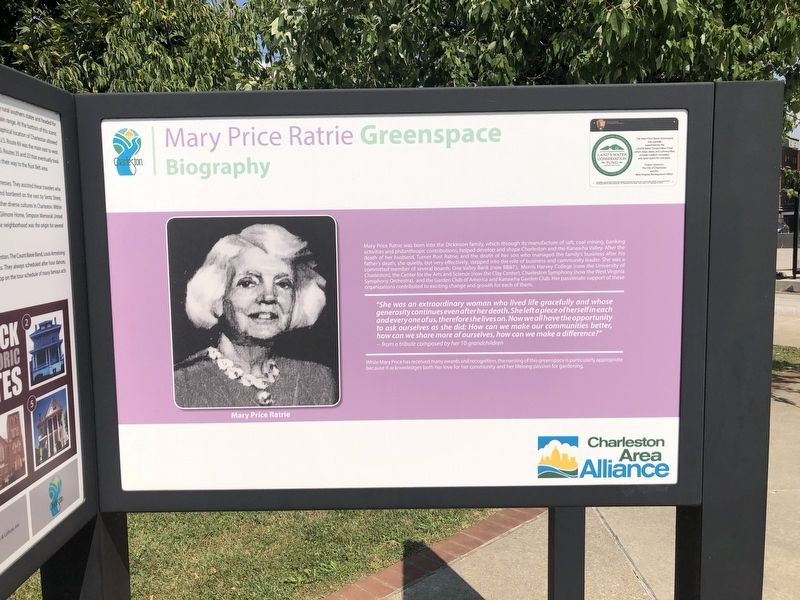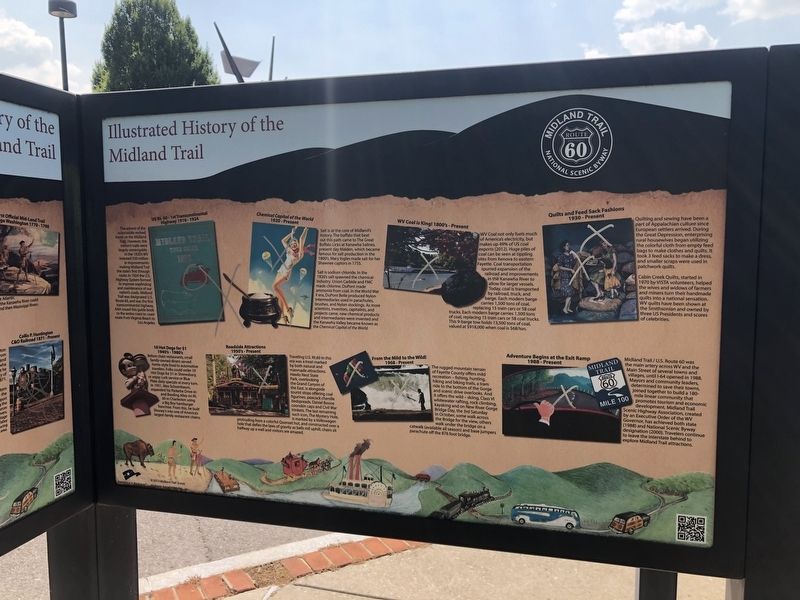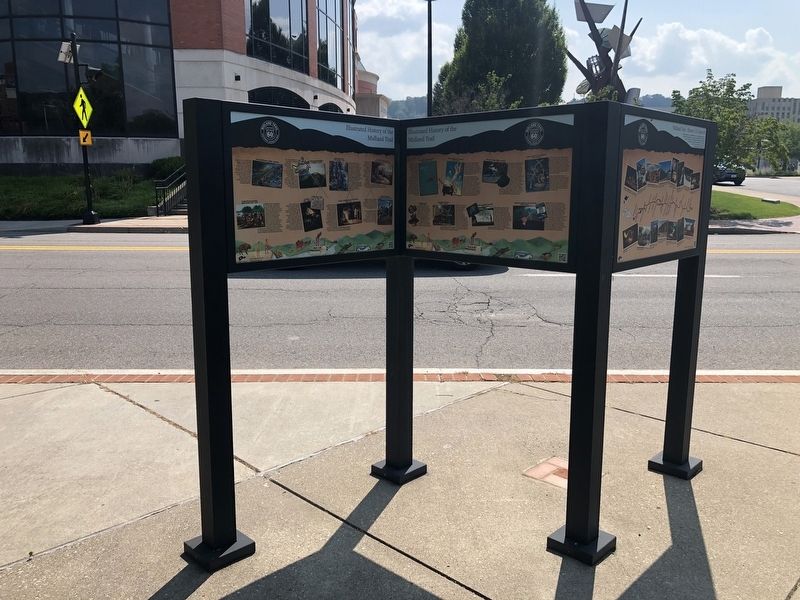Charleston in Kanawha County, West Virginia — The American South (Appalachia)
Mary Price Ratrie Greenspace / Illustrated History of the Midland Trail

Photographed By Devry Becker Jones (CC0), July 30, 2021
1. Mary Price Ratrie Greenspace side of the marker
Mary Price Ratrie Greenspace
Biography
Mary Price Ratrie was born in the Dickinson family, which through its manufacture of salt, coal mining, banking activities and philanthropic contributions, helped develop and shape Charleston and the Kanawha Valley. After the death of her husband, Turner Rust Ratrie, and the death of her son who managed the family's business after his father's death, she quietly, but very effectively, stepped into the role of business and community leader. She was a committed member of several boards: One Valley Bank (now BB&T), Morris Harvey College (now the University of Charleston), the Center for the ARts and Science (now the Clay Center), Charleston Symphony (now the West Virginia Symphony Orchestra), and the Garden Club of America and Kanawha Garden Club. Her passionate support of these organizations contributed to exciting change and growth for each of them.
"She was an extraordinary woman who lived life gracefully and whose generosity continues even after her death. She left a piece of herself in each and every one of us, therefore she lives on. Now we all have the opportunity to ask ourselves as she did: How can we make our communities better, how can we share more of ourselves, how can we make a difference?"
-- from a tribute composed by her 10 grandchildren
While Mary Price has received many awards and recognition, the naming of this greenspace is particularly appropriate because it acknowledges both her love for her community and her lifelong passion for gardening.
Illustrated History of the Midland Trail
US Rt. 60 - 1st Transcontinental Highway 1916 - 1924
The advent of the automobile revived travel on the Midland Trail. However, the nation's trails were largely unnavigable. In the 1920's WV invested $50 million in improvements making Midland Trial the state's first through route. In 1924 the U.S. Highway System formed to improve wayfinding and maintenance of our nation's roads. Midland Trail was designated U.S. Route 60, was the first transcontinental highway. AAA issued this guide book to the entire coast to coast route from Virginia Beach to Los Angeles.
Chemical Capital of the World 1920 - Present
Salt is at the core of Midland's history. The buffalo that beat out this path came to The Great Buffalo Licks at Kanawha Salines, present day Madlen, which became famous for salt production in the 1800's. Mary Ingles made salt for her Shawnee captors in 1755.
Salt is sodium chloride. In the 1920's salt spawned the chemical industry. Union Carbide and FMC made chlorine. DuPont made ammonia from coal. In the World War

Photographed By Devry Becker Jones (CC0), July 30, 2021
2. Illustrated History of the Midland Trail side of the marker
WV Coal is King! 1800's - Present
WV Coal not only fuels much of America's electricity, but makes up 49% of US coal exports (2012). Huge piles of coal can be seen at tippling sites from Kenova to eastern Fayette. Coal transportation spurred expansion of the railroad and improvements in the Kanawha River to allow for larger vessels. Today, coal is transported by railroad, truck, and barge. Each modern barge carries 1,500 tons of coal, replacing 15 train cars or 58 coal trucks. ThisEach modern barge carries 1,500 tons of coal, replacing 15 train cars or 58 coal trucks. This 9-barge tow holds 13,500 tons of coal, valued at $918,000 when coal is $68/ton.
Quilts and Feed Sack Fashion 1930 - Present
Quilting and sewing have been a part of Appalachian culture since European settlers arrived. During the Great Depression, enterprising rural housewives began utilizing the colorful cloth from empty feed bags to make clothes and quilts. IT took 3 feed sacks to make a dress, and smaller scraps were used in patchwork quilts.
Cabin Creek Quilts,

Photographed By Devry Becker Jones (CC0), July 30, 2021
3. Mary Price Ratrie Greenspace / Illustrated History of the Midland Trail Marker
10 Hot Dogs for $1 1940's - 1980's
Before chain restaurants, small family-owned diners served home-style food to automotive travelers. Folks could order 10 Hot Dogs for $1 in Shrewsbury or enjoy curb service or Blue Plate daily specials at every turn. In 1951, Alex Schoenbaum, expanded his Parkette Drive-In and Bowling Alley in Rt. 60 in Charleston using a Big Boy hamburger franchise. From this, he built Shoney's into one of America's largest family restaurant chains.
Roadside Attractions 1950's - Present
Traveling U.S. Rt. 60 in this era was a treat marked by both natural and manmade attractions. Hawks Nest State Park, overlooking the Grand Canyon of the East, is alongside tourist shops offering coal figurines, peacock chenille bedspreads, Daniel Boone coonskin caps and Civil War trinkets. The last remaining such icon, The Mystery Hole, is marked by the Volkswagen protruding from a colorful QUonset hut, and constructed over a hole that defies the laws of gravity as balls roll uphill, chairs sit halfway up a wall and visitors are amazed.
From the Mild to the Wild! 1968 - Present
The rugged mountain terrain of Fayette County offers mild recreation — fishing, hunting, hiking and biking trails, a tram ride to the bottom of the Gorge and scenic drive overlooks. And it offers the wild — skiing, Class VI whitewater rafting, rock climbing, kayaking and on the New River Gorge Day, the 3rd Saturday in October, some walk across the Bridge for the view, others walk under the bridge on a catwalk (available all season) and base jumpers parachute off the 876 foot bridge.
Adventure Begins ad the Exit Ramp 1988 - Present
Midland Trail / U.S. Route 60 was the main artery across WV and the Main Street of several towns and villages, until I-64 opened in 1988. Mayors and community leaders, determined to save their towns, joined together to build a 180-mile linear community that promotes tourism and economic development. Midland Trail Scenic Highway Association, created by an Executive Order of the WV Governor, has achieved both state (1988) and National Scenic Byway designation (2000). Travelers continue to leave the interstate behind to explore Midland Trail attractions.
Erected by Charleston Area Alliance; The West Virginia Center for African American Art & Culture, Inc. & The Northside Historic Community Group; America's Byways; Midland Trail Scenic Highway Association, Inc.
Topics. This historical marker is listed in these topic lists: Charity & Public Work • Industry & Commerce • Roads & Vehicles • Women. A significant historical year for this entry is 1916.
Location. 38° 20.925′ N, 81° 37.753′ W. Marker is in Charleston, West Virginia, in Kanawha County. Marker is on Washington Street East (U.S. 60) just west of Sentz Street, on the right when traveling west. Touch for map. Marker is at or near this postal address: 1108 Washington St E, Charleston WV 25301, United States of America. Touch for directions.
Other nearby markers. At least 8 other markers are within walking distance of this marker. The Block Historic District / Midland Trail (here, next to this marker); Charleston Trails / Illustrated History of the Midland Trail (here, next to this marker); Mary Price Ratrie Greenspace (within shouting distance of this marker); The Block (about 600 feet away, measured in a direct line); Garnet High School (approx. 0.2 miles away); World War I Memorial (approx. 0.2 miles away); Saint John's Episcopal Church (approx. 0.2 miles away); Mattie V. Lee Home, Inc. (approx. 0.2 miles away). Touch for a list and map of all markers in Charleston.
Credits. This page was last revised on August 2, 2021. It was originally submitted on August 2, 2021, by Devry Becker Jones of Washington, District of Columbia. This page has been viewed 227 times since then and 28 times this year. Photos: 1, 2, 3. submitted on August 2, 2021, by Devry Becker Jones of Washington, District of Columbia.